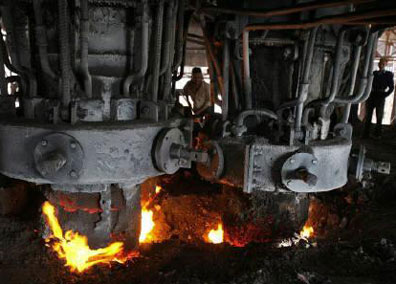 New Delhi:
New Delhi: India Inc. is much enthused by a new policy that seeks to raise the share of manufacturing in the country's gross domestic product (GDP) to 25 percent by 2022 from 16 percent now, but feels it is execution that holds the key.
India's first ever National Manufacturing Policy, which took two years to be framed, seeks to push industrial production and world-class infrastructure with fiscal incentives to give the much-needed impetus to investment.
At the same time it recognised that a manufacturing unit has to comply with as many as 70 laws and file something like 100 returns every year that puts off youth, who shy away from taking up an entrepreneurial role. India's GDP stands at around $1.4 trillion.
Given the government's intent in resolving these irritants, industry feels the time has come to take up these issues in a holistic manner so that youth are not forced to take up jobs below their potential and contribute to enhancing economic activity.
"It is a positive step but a lot will depend on implementation. The biggest challenge is not the policy itself, but the implementation," Sanjeev Krishan, executive director at PricewaterhouseCoopers (PWC), informed.
"Effective implementation of the policy is needed to boost business sentiments that have taken a beating in the recent times due to policy inaction and a series of scandals and scams," Krishan added.
At the core of the new policy is the creation of national investment and manufacturing zones and investment regions that will be autonomous self-governing townships developed in partnership with the private sector.
In that light, seven such projects have already been approved, all of which fall under the Delhi-Mumbai Industrial Corridor, covering Maharashtra, Madhya Pradesh, Gujarat, Rajasthan, Haryana, and Uttar Pradesh.
Since independence in 1947, only two planned cities have come up in India at Jamshedpur and Chandigarh and these industrial townships will be modelled on similar projects in China, South Korea, Thailand and Malaysia.
"Earlier, China, Japan and Germany did it. Now India has decided to do it," Commerce and Industry Minister Anand Sharma said after unveiling the new policy Tuesday. "These townships will be managed by a special purpose vehicle (a holding company)," he said.
"We welcome the proposal to create large national investment and manufacturing zones to achieve economies of scale and global competitiveness," said Rajiv Kumar, secretary general of the Federation of Indian Chambers of Commerce and Industry (FICCI).
"As the emphasis is on self-regulation in these zones, this would significantly bring down the compliance burden on the manufacturing units."
The policy also seeks to address the anomaly in India where the manufacturing growth is lower than overall growth. In countries like China, Thailand and Malaysia, industrial growth is distinctly higher and accounts for almost 40 percent of the national output.
"India is a young country with over 60 percent of its population in working age group," Minister Sharma said. "With over 220 million people estimated to join the work force in the next decade, manufacturing will have to create gainful employment for at least half this number."
Experts also said along with the push to manufacturing per se, there was also the need to rationalise the various tax regimes and do away with archaic octroi rules of various states that create trade boundaries and barriers within the country.
"Due to delays and dilution in much-hyped legislative actions such as the introduction of a Direct Tax Code and a pan-India Goods and Services Tax, many potential investors are skeptical about the actual implementation of any new policy," said PWC's Krishan.
"We hope the implementation of this policy will be done effectively and expeditiously. The states will also have a major role to play," said Harsh Pati Singhania, managing director of JK Paper.
The policy is also bold enough to speak about the tricky subject of exit policy and says it should be easier to close down factories not performing well so that resources can be deployed elsewhere. For that it wants a strong social security net.
Little wonder industry feels the policy is emitting positive signals and spells out the direction the policy-makers intend for manufacturing. More so since the government, too, is concerned over the current global slowdown and the impact on domestic economy.
Manufacturing output that includes cars, television, clothing, cement and steel grew at a sluggish rate of six percent in the first five months of this fiscal, as against 9.2 percent in the like period of last year, as per latest data.
"Timing of the approval is also important and assumes greater significance given the domestic business environment and current global uncertainties," said Chandrajit Banerjee, director general of the Confederation of Indian Industry.
Salient features of the first national manufacturing policy:
-- Creation of 100 million additional jobs in the next 10 years.
-- Increasing the share of manufacturing in GDP to 25 percent by 2022 from current around 16 percent.
-- Liberalisation in labour and environment regulations.
-- Single window clearance for all issues related to industrial units.
-- Setting up of national investment and manufacturing zones.
-- Mega industrial township equipped with world-class infrastructure proposes to be autonomous and self-regulated.
-- Special purpose vehicle created to develop infrastructure on public-private-partnership mode.
-- Incentives to states for infrastructure development.
-- Incentivisation of green technology.
-- Financial and tax incentives to small and medium enterprises.
 New Delhi: India Inc. is much enthused by a new policy that seeks to raise the share of manufacturing in the country's gross domestic product (GDP) to 25 percent by 2022 from 16 percent now, but feels it is execution that holds the key.
New Delhi: India Inc. is much enthused by a new policy that seeks to raise the share of manufacturing in the country's gross domestic product (GDP) to 25 percent by 2022 from 16 percent now, but feels it is execution that holds the key.